Katran is not a very famous culture, which is gaining popularity every year among gardeners. This root with confidence can be called the improved version of Khrena. If you grow horseradish on your site, then be sure to read the advantages of the cathrane. In this article we will get acquainted with one of the most sought-after varieties - Picadrom.
Katran Picader - Botanical Description
- Katran Picadrome is a grassy perennial belonging to the family of cruciferous.
- Katran Picadier grows in Europe, in Russia, in East Africa. In Russia, about 20 types of catran are growing in a wild form.
- The leaves of the cathode with a picade painted in a jaw-green color, have a smooth surface. The leaves in shape are egg-shaped, peristraysset.
- Picader Picadre Stem Picking, a little branching, capable of reaching 50 cm in height.
- The root system of the cathode with a picade rod, represented by the root of the elongated shape. Under favorable conditions and proper care, the root of the cathrane with a picade can reach up to 40 cm long and 4 cm in diameter. The rootpode has a correct conical shape and brown with a gray tint. Can reach the mass of 900 grams.
- Katran Pickadrome is considered a fairly productive cathrane variety. With 1 sq. M. You can collect up to 4 kg of harvest.
- Approximately in the middle of summer, the Katran Picader begins to bloom the fragrant small flowers of white. But you can only admire the Miloid Flowers on the 2nd or 3rd year after landing.
- The juicy pulp of the root of the root of the cathode with a picade to taste is similar to the pulp of Khrena. It has a white color, has a richer and valuable chemical composition than horseradish.
- The fruit of the cathrane Picadrome is a pod, inside which is 1 seed. When ripening, the pod is easily bursting.
- Katran Picader considers not only a drought-resistant plant, but also frost-resistant. With the onset of the cold, its above-ground part is dying, and the root deepens to the ground even more deeper than 4 cm. This allows the plant with ease to endure harsh frosts even without special shelter.
Katran Picadrome - where you can use
Consider where Katran Picader can be applied:
- food. Still, most often the Katran variety Picader is grown precisely for food purposes. Food is suitable both roots and leaves or plants. According to the taste characteristics, Katran is similar to horseradish, and some spicy additive connoisseurs believe that it even exceeds horseradish. Katran is used as a spiced additive when cooking vegetable and meat broths, fish dishes, snacks, pickles, marinades, sauces, gravy. Cathedral picadrome stems can be used as asparagus, fry in oil, add to salads;
- in folk medicine. Thanks to the rich chemical composition, Katran Picadrom is very often used as the main component in various recipes of traditional medicine. As part of the cathrean, pectin, inulin, vitamin C, potassium salt, calcium, magnesium, iron, essential oils, phytoncides, group vitamins, RR, large number of trace elements, sugar. Since ancient times, the katran is used as a wound-healing agent, antimicrobial, antiviral. Katran Picodrome has a relaxing effect on the human body, is able to have anti-cutting effect, favorably affect the operation of the gastrointestinal tract organs, is able to raise appetite. Despite the fact that Katran Picadrom has such a versatile positive influence on the body, to apply it in some cases standing with caution or to refuse at all. For example, persons with individual intolerance to this root, it is worth avoiding its use, people with ulcerative stomach disease, colitis, gastritis, with some chronic kidney disease;
- in animal husbandry. The above-ground part of the cathrane serves as an excellent feed for small and cattle;
- in beekeeping. If you decide to put on your site Katran Picader, then be prepared for the fact that the plant will attract the bees to him. Katran - valuable culture-honeycomb;
- in industry. The cathrane seeds contain a large amount of oils. The plant can be used to obtain lubricants, wax, technical oil.
Katran Picadrom - landing
Choosing a place to land the cathrane with a picade
- Katran Picadrum prefers to grow on well-lit areas. If you can't find such a sunny place in your site, then this is not a problem. Plant Katran Picadrome on a seventeater sector. Under such conditions, the above-ground part of the plant will not be too high, but the harvest of the root crusts you still collect a good.
- Katran Picader does not like to grow in wetlands. Choose such a place where the groundwater proceeds to the surface of the soil is not too close.
- When choosing a place to land the cathrane Picader, it is also worth considering which plant grew earlier in one or another place. Katran should not land after plants belonging to the family of cruciferous, due to the risk of contamination of Kila.
- It is desirable to plant a picodra in a place where the cucumbers, beans, potatoes, eggplants, tomatoes have grown before that.
Some gardeners are afraid to grow Coman Picader in their plot, as they are confident in his "aggressiveness". But this plant absolutely does not clog the plot, grows peacefully. Some even add part of the catran when mulching the soil, since it contains substances that accelerate plant growth in a natural way.
We choose the soil for landing the cathrane with a picade
If you are worried that the soil on your site is not too nutritious for growing cathrane with a piker, then your fears are in vain. This culture is completely unpretentious to the composition of the soil. Consider its minimum "requirements" to the soil:
- katran Pickadrome does not like heavy clay soils too much. In such a place, seeds may simply do not germinate;
- katran Picadrome did not like wetlands and clay soils, plots with close adjacent of groundwater;
- katran Picader on loose, breathable and nutrient soils is best increasing;
- if there is an acidic soil with a slight area, it can also become a small obstacle to growing the cathode with a picade. Such a soil before boarding the cathrane must be made mandatory. Otherwise, the plant will grow badly, will be infected with various fungal diseases;
- ideal soils for the cultivation of Catran Picadrome - Suglinki and letters.
TECHNOLOGY LANDING CATRAN PIKADER SEEDS
Since the catranian seeds with a picade have a rather dense shell, they need stratification for successful germination. It is possible to conduct it in a natural way and "forced". Natural stratification of cathrane seeds Picadrome is worth a prejudgement. If you want to put a caran in the spring, then the seeds need to withstand in the refrigerator for 2 months in a wet soil. It happens that Katran begins to give sprouts already in the refrigerator. After a 2-month period, the cabinet with sand is put on the lit window sill. After about 40 days, you will get a full quatrane seedlings with a picade with 5 real leaves, which is ready for disembarking into an open ground. Consider a Read more Planting Process:
- before boarding the cathrane, the Picader needs to prepare a plot. Thoroughly shry the land, remove the weeds. If the soil on the area is sour, then make a lime. For this, 100-300 grams of lime and 300-500 grams of wood ash are introduced for 1 sq. M.
- to land, telect the largest cathode seeds with picodrome. It is such a landing material at proper stratification to give good and strong shoots;
- seeds before planting in an open ground or before stratification in the refrigerator (basement), it is necessary to soak in a weak solution of mangalls for 2 hours;
- katran Picadrome - a plant that is almost still equal to which soil it will grow. If you land this perennial on too scanty soil, you can easily feel it. To do this, 3-4 kg of manure per 1 sq.m, 40 g of phosphorus-potash fertilizers per sq.m. You can also use any ready-made comprehensive mineral organic fertilizer;
- if you have chosen the pregnant fit of the cathrane with a picade, then it follows it in October-November. On the garden, make a grooves in a depth of about 3 cm. The distance from one groove to the other should be from 70 cm to 90 cm. For each traffic point meter of such a bed should go about 10-12 cathode seeds with a picade;
- press the seeds into the moistened soil and suck the ground;
- after planting the cathrane, the picader makes the soil mulch by humus;
- at a temperature of +4 degrees, the katran picodrome begins to germinate. The greatest revisions in the growth and development of the plant recruits at a temperature of +19 degrees to +25 degrees. Do not worry if the frosts happened after the landing. Katran is the perennial culture that is known for its frost resistance. Short-term freezing to -6 degrees are not terrible even for young plants.
As the plants grow and develop, they need to break their thinning. The minimum distance between individual plants should be about 35-45 cm. Do not think that the root of the cathode is formed in the first year after landing. In the first year, only 5-6 leaves rosette is formed, the next year their number will increase to 20 pieces and the root plant will appear. On the 3rd year after landing, Katran will begin to bloom in the summer.
Katran Picader - Care
Beginners of gardeners can safely grow this perennial in their plot. Cartman care, including the variety of a picade, is absolutely no difficulties.
- After the appearance of 2-3 leaves, it is very important to swing the landing of the cathode with a picade so that a distance of about 30-40 cm remains between individual plants.
- A bed with a katran picade must be pouring to maintain not only aesthetic appearance of the planting, but also protect the carton from diseases and pests, whose pedestrians can be a weed grass.
- Cartaran varieties with a picade, as well as horseradish, requires watering as needed. The most abundant watering falls at the end of May. At this time, 1 sq. M. It is necessary to spend about 30 liters of water. During periods of drought, it is advisable to use liquid fertilizer forms if you are going to enter them.
- Periodically loose aisle to ensure a good air flow to the roots of the plant.
- In order to "pamper" the Katran variety a picade, you can feed it about 2 times per season. The first feeding of the ammonium Selitra is produced at the time of breaking the garden. This will require 10-15 g of ammonium nitrate for 1 sq.m. After the Catrana appears about 5 real leaves, you can feed it with potash salt (10-15 Gy) and ammonium Selitra (7 Gy) in the calculation of 1 sq.m.
Katran Picadrome - Reproduction
It is possible to grow a katran picader not only from seeds, but also from root processes. Such planting material is harvested in the fall during harvesting.
- Root processes are cut by a length of about 10-15 cm, communicate with each other and are deposited to the basement at a temperature of 0 degrees. They will expect spring for landing into an open ground.
- It is very important not to confuse the upper and lower part of the root process to know how it is then planted in an open ground. You can make different cuts. For example, at the top Make an oblique incision, and at the bottom of the root process - direct incisions.
- In the spring, inspect the planting material, remove all the side kidneys except the top. You can start a landing after the earth will overtake.
- Space Katran obliquely. A distance of 10 cm should remain between the root processes. As planting plants grow, it will be necessary to break.
Katran Picadrome - Harvest Rules
- Collect the delicious and incredibly useful harvest of root cathrane picadrome in late September. If you eat leaves or stalks of the cathrane, you can collect them during the summer.
- Roots reach good sizes only on the 2nd or 3rd year after landing.
- With the help of garden, the carton is gently crawling, remove the root corner from the ground. An overhead part of the plant before removing the root plant is to cut off.
- Roots are cleaned from the ground.
- Katran Picadrome perfectly led to storage. You can fold it into the boxes, moving each layer of sand, and store them in the basement at a temperature of about 4-5 degrees of heat and air humidity 85%. Katran can be stored in the refrigerator.
- If we use in nutritionals only the above-ground part of the cathrane of the Picader variety, then the plant can grow at the same place to 15 years.
Coman Picadrom - Reviews
- Irina Vladimirovna: "My grandmother has always grown a beautiful flowering plant in her garden, whose names I did not know. Later I learned that it was Katran - an analogue of Khrena. Also began to grow this root plant at its dacha and was very surprised. The taste of the cathrane for me seems much more pronounced and spicy than the taste of ordinary shit. The advantage of cultivation consider the complete unpretentiousness of this herbaceous perennial in care. "
- Ilya Andreevich: "Katran has long settled on my site. Few people know, but the "store" hell in jars often make it from Katrana, and not from Khrena. Roots on the 3rd year reaches excellent sizes, unprecedented juits and harmonious taste. And the Katran Pickadrome in landing and leaving is a very unpretentious plant. "
- Olga Matveyevna: "At the bottom of his friend, the Zrena Zreno - Katran was decided at the cottage. The store was able to find seeds only one variety - a picade. The first attempt to plant the seeds in the spring in the open ground became failed, since nothing climbed. Then I learned that the seeds would definitely be exposed to cold before planting. I did everything right and waited 100% shoot. It's very easy to care for the plant. I would even say that Katran Picader grows in itself, without needing for my participation. "
- Irina Sergeevna: "Very often love to use horseradish as an additive for sauces, broths, other dishes. But I didn't like this plant at the cottage. Fuck quickly floats the space around him. A neighbor proposed to plant instead of Catran, since it does not differ in such aggressive growth. I was pleasantly surprised by this fact. We grow the Katran variety a picade, which is completely satisfied with my taste preferences. "

Katran Picader - Growing Secrets
- When cultivating the cathode, choose the largest seeds with a picader.
- Be sure to expose the catranian seeds with a picade before landing stratification or go to the open soil in front of the winter.
- Do not choose a place to land the cathrane with a picade, where the cabbage grew before. These plants have similar diseases and pests.
- Cruciferous flea - the frequent pest of all plants from the family of cruciferous, including Catran Picadrom. To protect the perennial from the flea, planted next to the bow-lathouse, the smell of which has a disconnecting effect on the insect.
- If you do not pull the root root of the cathrane from the ground, then the plant will be able to grow about 10-15 years in one place.
- Katrana Picadrome roots can not be filled with autumn, but leave them in the soil until spring.
As you can see, Katran Picader can easily become a permanent "resident" on your bed. Applying at least a landing effort, care, in return you will get a useful harvest - a source of various vitamins and microelements. Successs in the cultivation of Catrana!

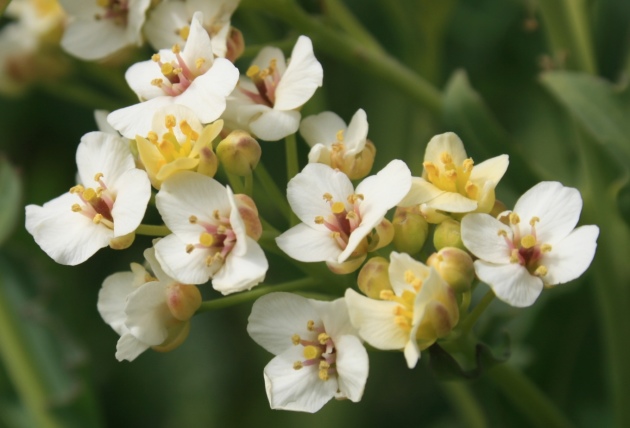
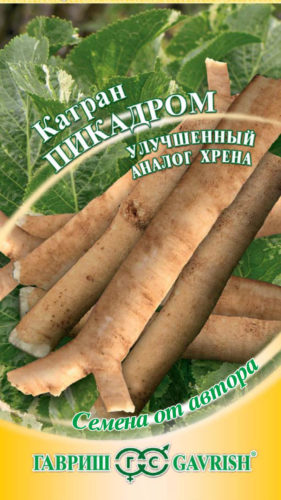
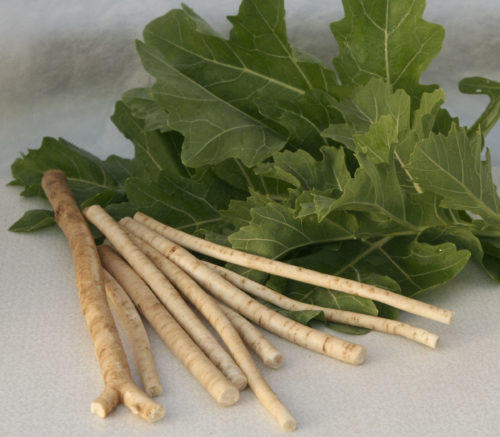
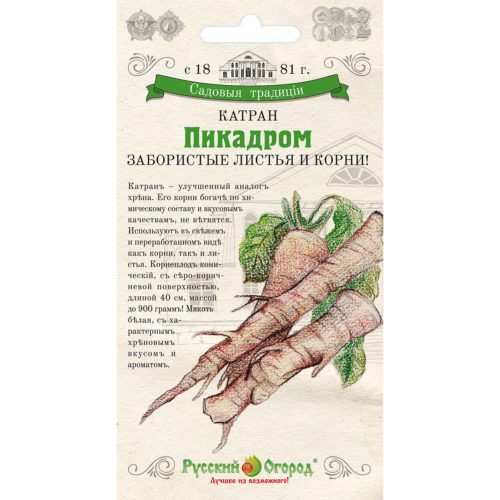
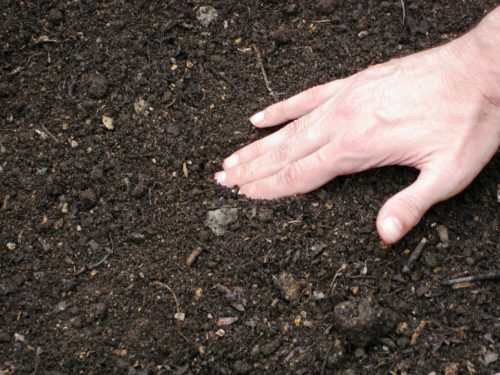
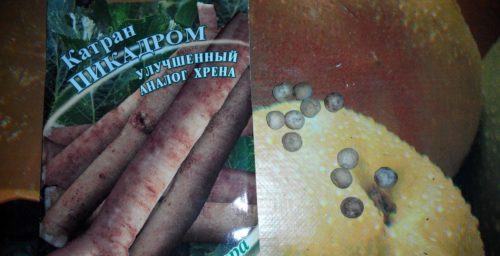
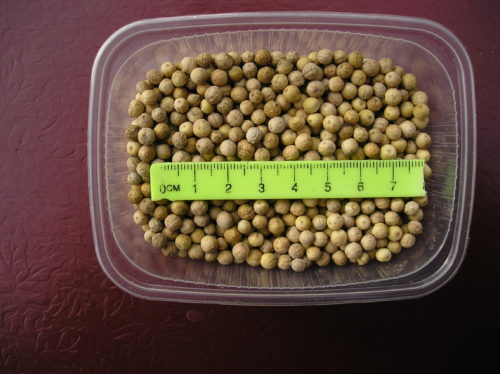












 Start a discussion ...
Start a discussion ...